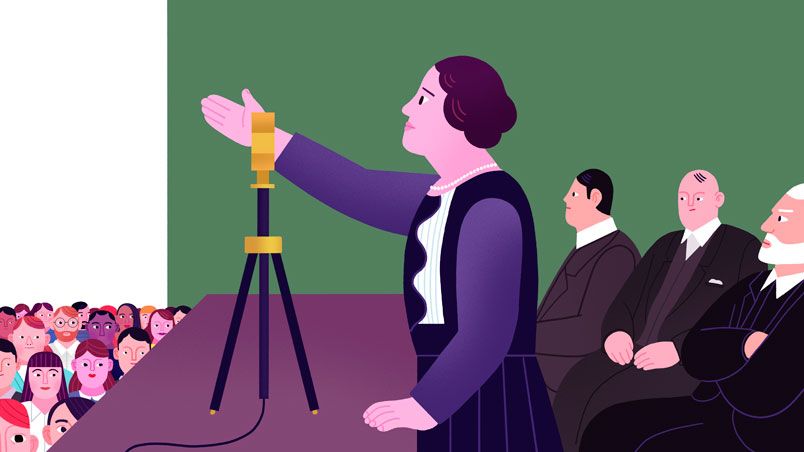Women's walking tour

"There are many women who have shaped the history and character of the city. Some of us are really known to the public, but others remain unknown. Would you like to discover our stories? Come with us!"
Women's city
How much do you know about the women in the history of San Sebastian? Apart from the image of the "Belle Époque" queens, María Cristina and Victoria Eugenia, we know very little about other female citizens who were part of the city's legacy. In order to understand the history of San Sebastian, it is essential to know their lifestyle, their achievements and the work they carried out. On this tour you will uncover these women who have gone unnoticed and recover them from oblivion.
Thus, you can imagine the cigar makers of the old Tobacco Factory of Egia in the current Tabakalera; you will uncover the Duchess Cristina Brunetti in the park that bears her name; through the streets of the Parte Vieja (Old Town) you will explore the work done by Katalina Eleizegi, pioneer of modern theatre in Basque, and by the andereño (teacher) Elbira Zipitria, promoter of education in the Basque language; We will recall the laundresses who washed the clothes of the wealthiest families and those of the hotels in the Urumea River, as well as the seamstresses, baserritarras (peasant women), nannies and maids who worked for Queen María Cristina and her entourage in the Miramar Palace; the sardine sellers and saleswomen of the port; the meteorologist Felisa Martín, the first to obtain a PhD in Physics; the 17th century corsair and tavern keeper Juana Larando; and many others. Many pioneering women have had an impact and continue to do so on the future of our society.
Interactive map of the route
Select the locations
Distance
Stops
Time
1. Tabakalera
Who would have thought that we, the former workers of the Egia Tobacco Factory, that artists and creators from different disciplines and film students would work in this building, that they would be the new neighbours of this gigantic factory converted into a cultural centre? The factory is still today one of the largest buildings in San Sebastian; we were around 1,000 workers, most of us were women, and we were cigar makers. Whenever we women left the factory, it was a grand event: dozens of women would cross the main gate holding each other's arms and in a joyful atmosphere.
In San Sebastian, the creation of the Tobacco Factory in 1878 allowed us women to work in the industry. They first opened it in the centre, in calle Garibay, but it soon became too small. It was then that they decided to open the large factory in Egia, next to the train station and the Cristina Enea park. It was inaugurated in 1913. Being a cigar maker was a privilege, as the wages were higher than those of other jobs. This economic independence gave us cigar makers from San Sebastian a special status. The Tobacco Factory closed in 2003. San Sebastian City Council, the Guipúzcoa Provincial Council and the Basque Government decided to build an international centre for contemporary culture, and in 2015, after a renovation process, they opened the new cultural centre.

1 Tabakalera
2. Cristina Enea park
Did you know that the park is named after Cristina Enea in my honour? My name is Cristina Brunetti y Gayoso de los Cobos. I inherited the duchy of Mandas and Villanueva, and in 1859, when I married Fermín Lasala y Collado, we became the dukes of Mandas. We built our palace in this park, next to Tabakalera, in the Egia neighbourhood. It is one of the best known natural spaces in the centre of San Sebastian, but perhaps little is known about its origins and the treasures it houses. It is one of the lungs of the city and covers an area of almost 95,000 square metres. In 1883 we started planting trees from various origins and they are still alive: there is a Lebanese cedar, pedunculate oaks and sequoias, among other varieties.
Fermín Lasala and I had no offspring, and we decided to bequeath the property to the City Council, thus bestowing our estate as a gift to the city. Since 1926 it has been a large park for the enjoyment of all. Strolling through the park you will come across peacocks, which have become a symbol of this place, and when you reach the pond you will be able to spot the swans and ducks that inhabit this place. Nearby was the former palace of the dukes. It is now the headquarters of the Cristina Enea Foundation's Environmental Resources Centre.
There is a circular esplanade in the highest part of what used to be our estate, which since the 1970s has become a place of homage to a young environmentalist from Egia. Her name was Gladys del Estal and she was part of the environmental and anti-nuclear group in the neighbourhood. She had a close relationship with the park because she used to organise activities for young people here. On 3 June 1979, anti-nuclear actions were organised all over the world. In the Basque Country, the protest took place in Tudela. The protest was peaceful, but the demonstrators were attacked and Gladys del Estal was shot dead. She was 23 years old.
In the summer the park hosts the Glad Is The Day music festival. The festival's name is a pun in homage to environmental activist Gladys del Estal. The event was created in 2016 to commemorate the designation of San Sebastian 2016 as European Capital of Culture. The festival has two main goals: to enjoy the park and to offer a musical programme for all audiences.

2 Cristina Enea park
3. Hotel María Cristina
Hotel María Cristina is one of the first luxury hotels in San Sebastian. I, Bette Davis, was invited by the San Sebastian Film Festival in 1989, because since its establishment in 1953 it has been customary for celebrities to stay at the hotel. The chronicles of the time say that I was the big star of the 37th edition of the festival, which turned out to be my last public appearance, as two weeks later I passed away in a Paris hospital. I was classic Hollywood's greatest star and I was honoured with the Donostia Award, the festival's most important honorary prize.
The hotel was opened in 1912 by Queen María Cristina herself. From 1893 she spent all her summer stays in San Sebastian, thus attracting the Spanish aristocracy to the capital of Gipuzkoa. The hotel is one of the works carried out at the time when royalty and numerous aristocrats spent their summers in the city, and it was one of the social epicentres of those years.
Archduchess María Cristina belonged to the Austro-Hungarian imperial family. In 1879 she married Alfonso XII, King of Spain. They had two daughters and in 1885, when the queen was three months pregnant, Alfonso XII died of tuberculosis. María Cristina took over the regency until 1902, when Alfonso XIII came of age. Hotel María Cristina and the María Cristina Bridge are named after her, and in 1926 she was named Honorary Mayoress.

3 Hotel María Cristina
4. Kursaal Conference Centre
I am Clara Campoamor, suffragette, politician and lawyer from Madrid. I have been involved in politics and feminism since I was young. Near here, on Paseo Ramón María Lili, there used to be a pelota court called Urumea. I was there on 5 April 1931 in front of 6,000 people; I spoke at a rally of the Radical Socialist Republican Party to demand women's right to vote. The 1931 Constitution finally achieved the recognition of women's right to vote. In the midst of the war of 1936, I had to go into exile, and I never returned.
San Sebastian fascinated me. I was here when they proclaimed the II. Republic, and I asked to be buried in the city. My tomb is in the Polloe cemetery, in the pantheon of the Monso Riu family, of whom I was the matron. There is a sculpture in my honour on the Paseo de la Concha.
There is a beautiful view of the Urumea from the Kursaal, a place that also serves to recognise the work of more women. For example, the work of the humblest women, those who lived near the Urumea, and whose livelihood was washing clothes in its waters. For instance, in the Urumea, the laundresses cleaned the sheets of Hotel María Cristina.

4 Kursaal Conference Centre
5. Victoria Eugenia Theatre
The Victoria Eugenia Theatre has been a breeding ground for many artists, and renowned professionals have performed on its stage. I am the dancer Lucía Lacarra. My first dance here was when I was 18 years old, with Víctor Ullate's company. I have been dancing every day for more than three decades and I have performed in the most distinguished theatres. I left home when I was 13, from Zumaia: I first went to San Sebastian, then to Madrid, and then gradually further and further away.
The soprano Ainhoa Arteta was a great success here in a performance as part of the Musical Fortnight, as was Montserrat Caballé. Major film celebrities have also come here to collect some of the Film Festival awards and to present films: Sophia Loren, Audrey Hepburn, Catherine Deneuve, Carrie Fisher, Susan Sarandon and Elizabeth Taylor, among others.
The singer Lourdes Iriondo, from the Basque group Ez Dok Amairu, has also been on this stage, as well as numerous Basque actresses. Since 2019, around March 8, the Gure Ahotsak festival has been held to recognise the work of women who dedicate themselves to music.
The theatre is named in honour of Victoria Eugenia de Battenberg, who was Queen consort of Spain following her marriage to King Alfonso XIII. The building is next to the Hotel María Cristina, mother of Alfonso XIII.
It has been a theatre as well as a trench. During the 1936 war, pro-Republican militiamen entrenched themselves in the Victoria Eugenia. The military supporters of Franco's regime took over Hotel María Cristina. They were shooting for two days from one building to another. That is why there are bullet holes in the facades of these two buildings. The anarchist militant Kasilda Hernáez is one of the women who was in the front line of the anti-Franco struggle. She was on the front in the centrally located calle Larramendi, defending the republic.

5 Victoria Eugenia Theatre
6. San Vicente Church
I am the andereño (teacher) Elbira Zipitria. I was born in Zumaia, but when I was young I came to the Parte Vieja (Old Town) of San Sebastian and taught my first Basque classes in the neighbourhood, in 1926, near the San Vicente church, in calle Juan de Bilbao. However, the war of 1936 and the harsh Franco dictatorship that followed interrupted teaching in Basque, as the Basque language was banned. I myself had to go into exile. I returned a few years later and continued with the work I had started before the war. In the 1940s, at the request of several families in San Sebastian, I began to teach Basque to their children, although they were totally clandestine. In those clandestine schools, the ikastola movement was sown, which spread throughout the Basque Country.
As well as being euskaltzale (Basque-speaking enthusiast), I was a great believer, and we have two churches in the neighbourhood: San Vicente and Santa María. San Vicente is the oldest church in the city, located between calle 31 de Agosto and calle Narrica. Designed in Gothic style, between the end of the 15th and the 16th century, it is a church built on top of an earlier temple. However, as a result of an earthquake in 1688, it was destroyed and had to be almost completely rebuilt, the result of which is the church you can visit today.
The entire city had to be rebuilt after the 1813 looting and fire. Continuing along calle 31 de Agosto, in the Plaza Valle Lersundi, you will come across a sculpture that pays homage to the locals who worked to rebuild the city. The sculpture represents a woman rebuilding the city stone by stone, carrying a basket full of bricks. In addition to working on the reconstruction of the city, the women did the necessary work for the city to prosper. They were in charge of carrying and selling goods from the caseríos (typical Basque Country farmhouses) to the city. Every day they came to La Brecha market, with their baskets on their heads full of products to sell. The current Plaza de la Constitución was the first market square in San Sebastian.
In the 19th century, women also carried out marine-related work, unloading sardines and other fish in the port, salting them, selling them, sewing the nets, etc. They also transported fresh fish to nearby towns in baskets.

6 San Vicente Church
7. City Council
What was an exotic spy and dancer from the Netherlands like me doing in the building that now houses the city council? I am Margaretha Geertruida Zelle, better known as Mata Hari, and in my day there was a festive atmosphere in today's city council building. The building was opened as a casino in 1887 and attracted well-known guests to the parties that took place there. At the beginning of the 20th century, and especially from World War I onwards, fleeing from the war, the great millionaires of Europe, the aristocracy and the political class came to San Sebastian. The rooms of the Casino were used for everything, and had political and social importance. I enjoyed those parties and dances. I left San Sebastian and in 1917 I was arrested in a hotel in Paris. They accused me of spying for Germany, and I was shot.
Near the City Council, in the Main Theatre of the Parte Vieja (Old Town), the oldest theatre in the city, we can retrace the story of another woman: Katalina Eleizegi. The epicentre of Basque theatre in the early 20th century was in San Sebastian, in the Main Theatre on calle Mayor. In 1916 she published her first work: Garbiñe. Eleizegi turned female characters into protagonists and told the history and traditions of the Basque Country, especially that of the women themselves. She has been considered the forerunner of modern theatre in Basque.
We are near the sea and the port, and although we usually think of women as net-makers or fishmongers, they were also involved in many other activities related to the sea. In the 17th century, Juana Larando's inn on the quayside in San Sebastian became a refuge and meeting place for the corsairs of the time. Larando would provide them with accommodation until they set sail and found a treasure. San Sebastian became a port for corsairs. Between 1662 and 1697, 150 shipowners had a privateer's licence. This activity was quite common and Larando can be defined as an entrepreneur of the time.

7 City Council
8. Miramar Palace
Queen María Cristina enjoyed herself so much the first time she came to San Sebastian, in 1887, that she expressed her wish to return the following year. Not only that, but she commissioned the construction of the Miramar Palace. She spent her summers here for 40 years; and not only the queen, but also her entourage, and all the workers who served her.
The palace was built on the privileged vantage point that separates the beaches of Ondarreta and La Concha. Many workers worked in Queen María Cristina's palace and in the gardens in the area, taking on numerous tasks. Some of us worked to attend to the day-to-day needs of the royal family who came from Madrid and the entire entourage that accompanied the family: laundresses, butlers, gardeners, horsemen, cleaners, waiters, maids and cooks, among others. The women of San Sebastian and the women of nearby towns in Gipuzkoa also have something to tell us about the history of the Miramar Palace.
You can also see Mount Igueldo from Miramar Palace, where the physicist Felisa Martín from San Sebastian worked. She was the first woman to obtain a PhD in Physics. In 1928, like so many physicists of the time, she applied to work at the State Meteorological Agency and prepared for competitive examinations. She began working there in 1929. She was the first and only woman at the Igueldo Meteorological Observatory until 1935. Felisa Martín spent her time at Igueldo researching galernas, the sudden, cold and strong gusts of wind in the Bay of Biscay.
A bust of Catalina de Erauso can be found in the gardens surrounding the palace. She was born in 1585 in San Sebastian. She first became a nun, but later became a warrior and was also an ensign. At the age of four she was sent to the Dominican convent of nuns of San Sebastian in Antiguo, which later became the Miramar Palace, but she ran away dressed as a man. She took part in the Spanish Crown's colonial campaigns in the Americas and used names other than Catalina de Erauso. She finally chose the name Antonio de Erauso for her death in Mexico in 1650.

8 Miramar Palace
9. Anoeta Sports City
When we imagine this part of Anoeta we think of the crowds that come on football match days, however, the sports city is a whole world of its own. We are a lot of sportswomen. San Sebastian is the city with the most elite women's sports teams in Spain. In total, there are ten women's teams in the top category: Bera Bera in handball, Real Sociedad in hockey and football, Ibaeta Basket in basketball, Atlético San Sebastián in athletics, Txuri Urdin in ice hockey, Txuri Berri in curling, and Donostiarra and Donostia Arraun Lagunak in rowing. Donostia's women's sports teams compete in several sports.

9 Anoeta Sports City
Green Routes accessibles and interactives
































































